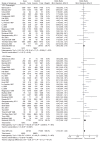Effect of body mass index on breast cancer during premenopausal and postmenopausal periods: a meta-analysis
- PMID: 23236502
- PMCID: PMC3517558
- DOI: 10.1371/journal.pone.0051446
Effect of body mass index on breast cancer during premenopausal and postmenopausal periods: a meta-analysis
Abstract
Objective: There is no universal consensus on the relationship between body mass index (BMI) and breast cancer. This meta-analysis was conducted to estimate the overall effect of overweight and obesity on breast cancer risk during pre- and post-menopausal period.
Data sources: All major electronic databases were searched until April 2012 including Web of Knowledge, Medline, Scopus, and ScienceDirect. Furthermore, the reference lists and related scientific conference databases were searched.
Review methods: All prospective cohort and case-control studies investigating the association between BMI and breast cancer were retrieved irrespective of publication date and language. Women were assessed irrespective of age, race and marital status. The exposure of interest was BMI. The primary outcome of interest was all kinds of breast cancers confirmed pathologically. Study quality was assessed using the checklist of STROBE. Study selection and data extraction were performed by two authors separately. The effect measure of choice was risk ratio (RR(i)) and rate ratio (RR(a)) for cohort studies and odds ratio (OR) in case-control studies.
Results: Of 9163 retrieved studies, 50 studies were included in meta-analysis including 15 cohort studies involving 2,104,203 subjects and 3,414,806 person-years and 35 case-control studies involving 71,216 subjects. There was an inverse but non-significant correlation between BMI and breast cancer risk during premenopausal period: OR = 0.93 (95% CI 0.86, 1.02); RR(i) = 0.97 (95% CI 0.82, 1.16); and RR(a) = 0.99 (95% CI 0.94, 1.05), but a direct and significant correlation during postmenopausal period: OR = 1.15 (95% CI 1.07, 1.24); RR(i) = 1.16 (95% CI 1.08, 1.25); and RR(a) = 0.98 (95% CI 0.88, 1.09).
Conclusion: The results of this meta-analysis showed that body mass index has no significant effect on the incidence of breast cancer during premenopausal period. On the other hand, overweight and obesity may have a minimal effect on breast cancer, although significant, but really small and not clinically so important.
Conflict of interest statement
Figures





Similar articles
-
Body mass index effects on risk of ovarian cancer: a meta- analysis.Asian Pac J Cancer Prev. 2014;15(18):7665-71. doi: 10.7314/apjcp.2014.15.18.7665. Asian Pac J Cancer Prev. 2014. PMID: 25292044
-
Body mass index had different effects on premenopausal and postmenopausal breast cancer risks: a dose-response meta-analysis with 3,318,796 subjects from 31 cohort studies.BMC Public Health. 2017 Dec 8;17(1):936. doi: 10.1186/s12889-017-4953-9. BMC Public Health. 2017. PMID: 29216920 Free PMC article.
-
The effect of body mass index on endometrial cancer: a meta-analysis.Public Health. 2015 Jul;129(7):872-80. doi: 10.1016/j.puhe.2015.04.017. Epub 2015 May 27. Public Health. 2015. PMID: 26026348 Review.
-
The role of body mass index in the relative risk of developing premenopausal versus postmenopausal breast cancer.Proc Soc Exp Biol Med. 1997 Oct;216(1):28-43. doi: 10.3181/00379727-216-44153b. Proc Soc Exp Biol Med. 1997. PMID: 9316608 Review.
-
Central obesity and risks of pre- and postmenopausal breast cancer: a dose-response meta-analysis of prospective studies.Obes Rev. 2016 Nov;17(11):1167-1177. doi: 10.1111/obr.12443. Epub 2016 Jul 19. Obes Rev. 2016. PMID: 27432212 Review.
Cited by
-
Assessing absolute changes in breast cancer risk due to modifiable risk factors.Breast Cancer Res Treat. 2015 Jul;152(1):193-197. doi: 10.1007/s10549-015-3411-6. Epub 2015 May 27. Breast Cancer Res Treat. 2015. PMID: 26012643 Free PMC article.
-
Prognostic Significance of VEGF-C Expression in Patients with Breast Cancer: A Meta-Analysis.Iran J Public Health. 2014 Feb;43(2):128-35. Iran J Public Health. 2014. PMID: 26060735 Free PMC article. Review.
-
Cancers Attributable to Overweight and Obesity From 2012 to 2014 in Nigeria: A Population-Based Cancer Registry Study.Front Oncol. 2019 Jun 11;9:460. doi: 10.3389/fonc.2019.00460. eCollection 2019. Front Oncol. 2019. PMID: 31245287 Free PMC article.
-
Helping women to good health: breast cancer, omega-3/omega-6 lipids, and related lifestyle factors.BMC Med. 2014 Mar 27;12:54. doi: 10.1186/1741-7015-12-54. BMC Med. 2014. PMID: 24669767 Free PMC article. Review.
-
Adiposity and cancer at major anatomical sites: umbrella review of the literature.BMJ. 2017 Feb 28;356:j477. doi: 10.1136/bmj.j477. BMJ. 2017. PMID: 28246088 Free PMC article.
References
-
- World Health Organization (2012) Breast cancer: prevention and control. WHO.
-
- World Health Organization (2006) Guidelines for management of breast cancer. Nasr: EMRO Technical Publications Series.
-
- van de Water W, Markopoulos C, van de Velde CJH, Seynaeve C, Hasenburg A, et al. (2012) Association between age at diagnosis and disease-specific mortality among postmenopausal women withHormone receptor–positive breast cancer. JAMA 307: 590–597. - PubMed
-
- Barlow WE, White E, Ballard-Barbash R, Vacek PM, Titus-Ernstoff L, et al. (2006) Prospective breast cancer risk prediction model for women undergoing screening mammography. J Natl Cancer Inst 98. - PubMed
-
- Sonnenschein E, Toniolo P, Terry MB, Bruning PF, Kato I, et al. (1999) Body fat distribution and obesity in pre- and postmenopausal breast cancer. Int J Epidemiol 28: 1026–1031. - PubMed
Publication types
MeSH terms
LinkOut - more resources
Full Text Sources
Medical
Miscellaneous

